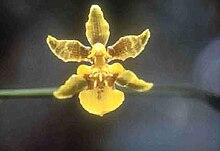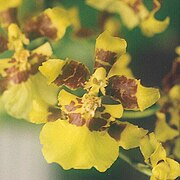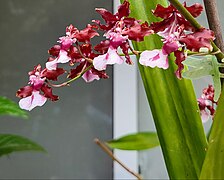| Oncidium | |
|---|---|

| |
| Oncidium altissimum | |
| Scientific classification | |
| Kingdom: | Plantae |
| Clade: | Tracheophytes |
| Clade: | Angiosperms |
| Clade: | Monocots |
| Order: | Asparagales |
| Family: | Orchidaceae |
| Subfamily: | Epidendroideae |
| Tribe: | Cymbidieae |
| Subtribe: | Oncidiinae |
| Genus: | Oncidium Sw. |
| Type species | |
| Oncidium altissimum (Jacq.) Sw. | |
| Synonyms | |
| |
Oncidium, abbreviated as Onc. in the horticultural trade, is a genus that, as of December 2023, contains about 340 species of orchids from the subtribe Oncidiinae of the orchid family Orchidaceae. It is distributed across tropical and subtropical America from Mexico, Central America and the West Indies to northern Argentina, with one species (O. ensatum) extending into Florida. Common names for plants in this genus include dancing-lady orchid and golden shower orchid.
A 2008 molecular phylogenetic study labeled the Oncidium alliance "grossly polyphyletic." In the same year, the American Orchid Society labeled the genus a "dumping ground". A consensus announced in April 2013 resulted in major taxonomic changes to Oncidium, Gomesa, Odontoglossum, Miltonia, and others. Much of this debate and subsequent housekeeping was initiated by significant research for the scientific publication Genera Orchidacearum Volume 5. As a result, much of the information in this article is now deprecated, but still of great value. One significant change is the move of most Brazilian Oncidium with a fused lateral sepal to the genus Gomesa. The Royal Horticultural Society system, the World Checklist of Monocots database and the American Orchid Society have updated their databases to reflect most of these changes.
Description
| This section does not cite any sources. Please help improve this section by adding citations to reliable sources. Unsourced material may be challenged and removed. (January 2021) (Learn how and when to remove this message) |
This genus was first described by Olof Swartz in 1800 with the orchid Oncidium altissimum, which has become the type species. Its name is derived from the Greek word ὀγκος, onkos, meaning "swelling". This refers to the callus at the lower lip.
Most species in the genus are epiphytes (growing on other plants), although some are lithophytes (growing on rocks) or terrestrials (growing in soil). They are widespread from northern Mexico, the Caribbean, and some parts of South Florida to South America. They usually occur in seasonally dry areas.
They can be divided into three categories, according to their growth pattern:
- Some have green pseudobulbs and long racemes with small flowers and a dominant lip. They are mostly golden yellow with or without reddish-brown barring, but some are brown or yellowish-brown. Other Oncidium species have white and pink blooms, while some even have startling, deep red colors in their flowers.
- Another group has extremely small pseudobulbs and stiff, erect, solitary leaves. These cylindrical leaves act as a water reserve. They have long racemes with yellow flowers that seem to fan out at the top. Sizes of these orchids can vary from miniature plants of a couple of centimetres to giants with 30 cm-long leaves and racemes of more than one metre long. These species, known as the Mule-Ears, are now classed as Psychopsis.
- Formerly there was a third group, called the Variegata or equitant oncidiums. They have no pseudobulbs, giving fan-shaped shoots of less than 15 cm, with triangular section leaves. These oval, broad and spongy leaves act as storage organs. Their flowers are most complicated with exquisite colors. The sepals are somewhat fleshy. The petals and the lip are membranaceous. These orchids are now classified as Tolumnia. Cyrtochilum is another genus that many Oncidium species have been reclassified into; Cyrtochilum species have extremely long, winding inflorescences that can sometimes reach 20' or more, curled petals that result in three-pointed blooms, and rambling growth habits in which each new pseudobulb appears on top of the old one.
Oncidium species are characterised by the following properties :
- presence of column wings,
- presence of a complicated callus on the lip (this can be used to separate the taxa),
- pseudobulbs with one to three leaves,
- several basal bracts at the base of the pseudobulbs.
The flowers come in shades of yellow, red, white and pink. The petals are often ruffled on the edges, as is the lip. The lip is enormous, partially blocking the small petals and sepals.
Some Oncidium orchids are very tall: Oncidium altissimum and Oncidium baueri can grow to a height of 5 m.
They are known as 'spray orchids' among some florists. They are very varied and are easily hybridised with other closely related genera forming the Oncidium alliance (Miltonia, Cuitlauzina, Miltoniopsis, Leochilus, Comparettia, Cyrtochilum, Tolumnia, Rhynchostele , Psychopsis, etc.). Some of the best Oncidium alliance hybrids originate from Oncidium tigrinum and Oncidium incurvum when crossed with species formerly placed in Odontoglossum, although hybridization possibilities of this group of orchids are endless, and there are literally hundreds of thousands of hybrids in the Oncidium alliance.



Selected species
Selected species accepted by Plants of the World Online as of December 2023:
- Oncidium altissimum : "Wydler's dancing-lady orchid" (Jamaica)
- Oncidium baueri (Trop. America)
- Oncidium cheirophorum (Mexico - Chiapas to Colombia)
- Oncidium citrinum (Trinidad to Venezuela)
- Oncidium deltoideum (N. Peru)
- Oncidium dichromaticum (Costa Rica to Colombia)
- Oncidium ensatum : (S. Mexico, Belize, Cuba, Florida, Bahamas, NW. Venezuela)
- Oncidium fuscatum (Ecuador to Peru)
- Oncidium geertianum (C. & SW. Mexico)
- Oncidium graminifolium (Mexico to C. America)
- Oncidium harryanum (Columbia)
- Oncidium hastatum (Mexico)
- Oncidium hastilabium (W. South America)
- Oncidium incurvum (Mexico - Veracruz to Chiapas)
- Oncidium lentiginosum (Colombia to N. Venezuela)
- Oncidium leucochilum (SE. Mexico to Guatemala)
- Oncidium lineoligerum (N. Peru)
- Oncidium maculatum (Mexico to C. America)
- Oncidium naevium (Colombia to Guyana)
- Oncidium noezlianum (N. Peru to Bolivia)
- Oncidium ornithorhynchum (Mexico to C. America)
- Oncidium reflexum (SW. Mexico)
- Oncidium sphacelatum (Mexico to C. America, SE. Venezuela)
- Oncidium strictum (Cogn.) M.W.Chase & N.H.Williams (Ecuador, Peru)
- Oncidium wentworthianum (Mexico – Chiapas to El Salvador)
Former species
Selected species not accepted by Plants of the World Online as of December 2023:
- Oncidium amictum → Gomesa × amicta (SE. Brazil)
- Oncidium auricula → Grandiphyllum auricula (SE. Brazil)
- Oncidium auriferum → Vitekorchis aurifera (Colombia to NW. Venezuela)
- Oncidium bicolor → Gomesa bicolor (NE. Venezuela to Brazil)
- Oncidium bifolium → Gomesa bifolia (Brazil to N. Argentina)
- Oncidium blanchetii → Gomesa blanchetii (E. & S. Brazil.)
- Oncidium brunleesianum → Gomesa echinata (Brazil - Rio de Janeiro)
- Oncidium ciliatum → Gomesa ciliata (SE. Brazil)
- Oncidium concolor → Gomesa concolor (Brazil to NE. Argentina)
- Oncidium cornigerum → Gomesa cornigera (SE. & S. Brazil to Paraguay)
- Oncidium crispum → Gomesa imperatoris-maximiliani (SE. Brazil)
- Oncidium croesus → Gomesa croesus (Brazil - Rio de Janeiro)
- Oncidium dasytyle → Gomesa dasytyle (Brazil - Rio de Janeiro)
- Oncidium divaricatum → Grandiphyllum divaricatum (SE. Brazil)
- Oncidium flexuosum → Gomesa flexuosa (E. & S. Brazil to NC. Argentina)
- Oncidium forbesii → Gomesa forbesii (Brazil - Minas Gerais)
- Oncidium gardneri → Gomesa gardneri (Ecuador, SE. Brazil)
- Oncidium hydrophilum → Gomesa hydrophila (Brazil to Paraguay)
- Oncidium klotzschianum → Oncidium nebulosum (Costa Rica to Venezuela and Peru)
- Oncidium longicornu → Gomesa florida (Brazil to NE. Argentina
- Oncidium longipes → Gomesa longipes (Brazil to NE. Argentina)
- Oncidium marshallianum → Gomesa marshalliana (SE. Brazil)
- Oncidium micropogon → Gomesa micropogon (Brazil)
- Oncidium pectorale → Gomesa pectoralis (Brazil - Rio de Janeiro)
- Oncidium praetextum → Gomesa praetexta (SE. Brazil)
- Oncidium pubes → Gomesa pubes (Colombia, SE. Brazil to NE. Argentina)
- Oncidium raniferum → Gomesa ranifera (SE. Brazil)
- Oncidium sarcodes → Gomesa sarcodes (SE. Brazil)
- Oncidium uniflorum → Gomesa uniflora (SE. & S. Brazil)
- Oncidium varicosum → Gomesa varicosa (Brazil to N. Argentina)
- Oncidium venustum → Gomesa venusta (Brazil)
Nothogenera
Many hybrids have been created artificially involving species of Oncidium, often with species of other genera. Named hybrid genera (nothogenera) are listed in the table below, together with their parent genera. As of December 2023, Cochlioda and Odontoglossum are included within Oncidium, and Baptistonia within Gomesa, so that nothogenus names which include these three genera are redundant.
| Nothogenus | Parents |
|---|---|
| × Adacidium | Ada × Oncidium |
| × Adoncostele | Ada × Oncidium × Rhynchostele |
| × Aliceara | Brassia × Miltonia × Oncidium |
| × Arthurara | Brassia × Miltonia × Oncidium × Rhynchostele |
| × Aspacidopsis | Aspasia × Miltoniopsis × Oncidium |
| × Aspacidostele | Aspasia × Oncidium × Rhynchostele |
| × Aspasium | Aspasia × Oncidium |
| × Brapacidium | Aspasia × Brassia × Oncidium |
| × Brascidostele | Brassia × Oncidium × Rhynchostele |
| × Brassidiocentrum | Brassia × Oncidium × Trichocentrum |
| × Brassidium | Brassia × Oncidium |
| × Brassidomesa | Brassia × Gomesa × Oncidium |
| × Brassoncidopsis | Brassia × Miltoniopsis × Oncidium |
| × Crawshayara | Aspasia × Brassia × Miltonia × Oncidium |
| × Cuitlacidium | Cuitlauzina × Oncidium |
| × Cyrtocidistele | Cyrtochilum × Oncidium × Rhynchostele |
| × Cyrtocidium | Cyrtochilum × Oncidium |
| × Cyrtoncidopsis | Cyrtochilum × Miltoniopsis × Oncidium |
| × Dunningara | Aspasia × Miltonia × Oncidium |
| × Gomiltidium | Gomesa × Miltonia × Oncidium |
| × Gomonciada | Ada × Gomesa × Oncidium |
| × Gomoncidochilum | Cyrtochilum × Gomesa × Oncidium |
| × Howeara | Leochilus × Oncidium × Rodriguezia |
| × Lockcidium | Lockhartia × Oncidium |
| × Milenkocidium | Miltonia × Oncidium × Zelenkoa |
| × Milmilcidium | Miltonia × Miltoniopsis × Oncidium |
| × Milonzina | Cuitlauzina × Miltonia × Oncidium |
| × Miltadium | Ada × Miltonia × Oncidium |
| × Miltoncentrum | Miltonia × Oncidium × Trichocentrum |
| × Miltoncidostele | Miltonia × Oncidium × Rhynchostele |
| × Miltonidium | Miltonia × Oncidium |
| × Oncidesa | Gomesa × Oncidium |
| × Oncidettia | Comparettia × Oncidium |
| × Oncidopsis | Miltoniopsis × Oncidium |
| × Oncidpilia | Oncidium × Trichopilia |
| × Oncidumnia | Oncidium × Tolumnia |
| × Oncostele | Oncidium × Rhynchostele |
| × Oncostelopsis | Miltoniopsis × Oncidium × Rhynchostele |
| × Otorhynchocidium | Oncidium × Otoglossum × Rhynchostele |
| × Pettitara | Ada × Brassia × Oncidium |
| × Psychocidium | Oncidium × Psychopsis |
| × Reicheara | Aspasia × Miltonia × Miltoniopsis × Oncidium |
| × Rodricidium | Oncidium × Rodriguezia |
| × Scelodium | Oncidium × Scelochilus |
| × Schunkeara | Brassia × Miltonia × Miltoniopsis × Oncidium |
| × Trichocidium | Oncidium × Trichocentrum |
| × Warneara | Comparettia × Oncidium × Rodriguezia |
| × Zelencidiostele | Oncidium × Rhynchostele × Zelenkoa |
| × Zelencidopsis | Miltoniopsis × Oncidium × Zelenkoa |
| × Zelenkocidium | Oncidium × Zelenkoa |
References
- ^ "Oncidium Sw." Plants of the World Online. Royal Botanic Gardens, Kew. Retrieved 2023-12-22.
- "My Huge List of Orchid Abbreviations". 13 June 2014.
- "World Checklist of Selected Plant Families: Royal Botanic Gardens, Kew". apps.kew.org.
- Flora of North America, v 26 p 648, Oncidium ensatum
- NRCS. "Oncidium". PLANTS Database. United States Department of Agriculture (USDA). Retrieved 22 July 2015.
- ^ Chase, Mark W.; Williams, Norris H.; Faria, De; Donisete, Aparacida; Neubig, Kurt M.; Amaral, Maria do Carmo E.; Whitten, W. Mark (1 August 2009). "Floral convergence in Oncidiinae (Cymbidieae; Orchidaceae): an expanded concept of Gomesa and a new genus Nohawilliamsia". Annals of Botany. 104 (3): 387–402. doi:10.1093/aob/mcp067. PMC 2720657. PMID 19346522 – via aob.oxfordjournals.org.
- ^ Lindleyana : The scientific journal of the American Orchid Society. December 2008 Pg 20
- "Kew News - Orchid community agree name changes in Oncidium". Archived from the original on 2013-06-24.
- Alec M. Pridgeon; Phillip Cribb; Mark W. Chase; Finn N. Rasmussen (eds.). "Genera Orchidacearum Volume 5 Epidendroideae (Part II)".
- "World Checklist of Selected Plant Families: Royal Botanic Gardens, Kew". apps.kew.org.
- "Baptistonia Barb.Rodr." Plants of the World Online. Royal Botanic Gardens, Kew. Retrieved 2023-12-24.
- "Alphabetical One-Table List of Genera and Intergeneric Hybrids" (PDF). Royal Horticultural Society. 2017. Archived from the original (PDF) on 2023-03-23. Retrieved 2023-12-24.
- Harry Zelenko :The Pictorial Encyclopaedia of Oncidium (1997)
- Koniger, W. 2003. New species of the genera Masdevallia, Oncidium and Sigmatostalix. Arcula no. 12: 298–311.
- Chase, Mark W.; Norris H.Williams; Aparacida Donisete de Faria; Kurt M. Neubig; Maria do Carmo E. Amaral; W. Mark Whitten (2009). "Floral convergence in Oncidiinae (Cymbidieae; Orchidaceae): an expanded concept of Gomesa and a new genus Nohawilliamsia". Annals of Botany. 104 (3): 387–402. doi:10.1093/aob/mcp067. PMC 2720657. PMID 19346522.
External links
| Taxon identifiers | |
|---|---|
| Oncidium |
|

